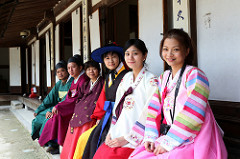Archive for 'Uncategorized'
Korean verb endings: 나요 Nayo Posted by Soo on Jan 18, 2016

Today, you will learn another verb ending which is “나요/Nayo” which expresses one’s wondering and supervise; it is for interrogative sentences and exclamation. The grammar pattern is “Verb + 나요 (먹다 + 나요 = 먹나요)”. When you use this verb ending, it sounds like you have really good Korean skills. In my personal opinion, more…
Korean Verb Endings: 네요 Posted by Soo on Jan 11, 2016

Today, you are going to learn one of most common verb ending “네요/Nae yo/”. It is a verb ending and an exclamation. For instance, I didn’t know: 몰랐네요 instead of 몰랐어요. It is the same meaning of “I didn’t know”, but the sounds will be different when you hear in Korean. Please read more examples…
Korean Verb Endings: 지, 죠 Posted by Soo on Jan 4, 2016

Today, you are going to learn one of useful verb ending in Korean. In the video below has good examples you can practice and study. I just want to add more explanation that 지 is expression of talk down, so you can use it only to your friend or young children. However, 죠 is abbreviation…
How to Say “While” in Korean (Part 2) Posted by Soo on Dec 28, 2015

Today, you are going to learn how to say “While” in another way of Korean, the grammar pattern is “V.S. + 는 동안에.” Remember, you can use the grammar patter when you want to describe that different people doing different actions. For instance, “I watched a TV program while my friend was on the phone/ 내 친구가 전화하는 동안에 나는…
How to Say “While” in Korean (Part 1) Posted by Soo on Dec 23, 2015

Today, you are going to learn how to use “While” in Korean, the grammar pattern is “V.S. + (으) 면서.” Remember this is the same person does both action. For instance, “I watched a TV program while I was on the phone” is good, but you can’t say “I watched a TV program while she was on the phone.” …
Top 5 Most Popular Korean Posts Posted by Soo on Dec 16, 2015

#5 Basic Phrases I tried to think of some useful phrases that might be useful at some point in your life. 여보세요 – (yoboseyo) hello (only used when answering the phone) 내일 만나요 – (neil manayo) see you tomorrow (literally, “meet tomorrow”) 다음에 또 봐요 – (daume ddo bayo) see you again next time 나중에 봐요…
Plurals – 들 Posted by Soo on Dec 7, 2015
Today you are going to learn how to use plurals in Korean, the grammar pattern is “Noun + 들”. Some dictionaries say that the grammar pattern is not right because it is from English and Korean don’t have to use 들 as a plurals. For instance, there are many people/사람이 많이 있다 or 사람들이 많이 있다 are the same meaning. It is…


